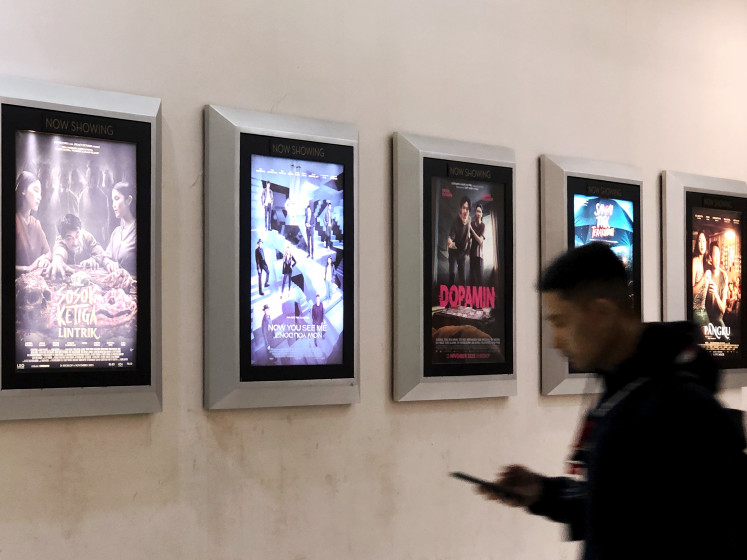Popular Reads
Top Results
Can't find what you're looking for?
View all search resultsPopular Reads
Top Results
Can't find what you're looking for?
View all search resultsSolving gridlock in Jakarta
Many policies have been proposed by the central government and the Jakarta city administration to disentangle Jakarta’s chronic traffic snarls
Change text size
Gift Premium Articles
to Anyone
M
any policies have been proposed by the central government and the Jakarta city administration to disentangle Jakarta’s chronic traffic snarls.
Vice President Boediono, after a meeting with several ministers and Jakarta Governor Fauzi Bowo early in September, proposed 17 policies to alleviate Jakarta’s maddening traffic gridlock, including electronic road pricing (ERP), two new Transjakarta bus routes and a program to clear the Transjakarta lanes of private vehicles, development of commuter train routes in Jabodetabek, prioritization of the MRT and monorail projects and the development of the Jakarta inner-ring railroad and six new inner-city toll roads.
The Jakarta city administration added some more policies to alleviate the traffic congestion in Jakarta, including changing traffic regulations in some congested areas (The Jakarta Post, Sept. 24, 2010), staggering office hours by zone in the five municipalities (The Jakarta Post, Nov. 3, 2010), and forming a task force to manage traffic in regular congestion hot spots (The Jakarta Post, Nov. 6, 2010).
The development and expansion of public transportation, including the MRT, monorail, Transjakarta, and commuter trains in the inner-city and suburbs of Jakarta, as recommended by Boediono, is key to reducing traffic congestion in Jakarta. Such developments should be prioritized and expedited.
Traffic management steps, including the application of ERP, the traffic law enforcement and the deployment of task forces to congestion hot spots, will support the effectiveness of mass transportation in alleviating the chronic transportation problems facing Jakarta.
The Jakarta Transportation Agency plans to apply the ERP in major thoroughfares where the three-in-one system is in place (The Jakarta Post, Sept. 23, 2010). The ERP would be an alternative when congestion levels in the restricted zone exceed a threshold. As a result efficient use of the roads and redistribution of trips spatially, temporarily and modally will follow (Albalate and Bel 2009; Goh 2002).
Jakarta needs to learn from the success of Singapore, which has implemented the ERP since April 1998. The ERP in Singapore is an upgrade of a previous congestion charge system, the Area Licensing Scheme (ALS), which was introduced in 1975.
The implementation of the ALS reduced traffic by 45 percent during peak morning rush hour and another 15 percent with the introduction of the ERP. One of the contributing factors to the success of the ERP was the strong commitment of the Singaporean authorities to develop and expand public mass transportation alternatives (Albalate and Bel 2009).
Other cities that have successfully implemented traffic congestion charging measures, including London and Stockholm, also have reliable, accessible and affordable public transportation.
Among the policies proposed by Boediono and the Jakarta city administration, I found two policies that could be counterproductive to the development and expansion of the mass transportation system: the development of six new inner-city toll roads and staggering office hours.
Both policies could ease traffic jams in the short run, but could create more traffic congestion in the long run. The policies will not encourage drivers to switch from their vehicles to mass transportation as their primary transportation mode. They will only undermine efforts to develop the mass transportation system in Jakarta.
Alternatively, many possible policies could be implemented in Jakarta in order to alleviate traffic congestion including introducing shuttle services, carpool matching services, telecommuting and downzoning. Instead of staggering office hours, the Jakarta city administration should encourage private and public companies to expand their shuttle services and develop carpool matching services for their employees.
Telecommuting is a way to reduce commuting by using telecommunication technologies. Employees can work outside the traditional office at remote work locations including their homes. A study in the US showed that telecommuting can reduce commuting by 10.4 percent of the labor force (Cullingworth and Caves 2009).
Downzoning is a measure to reduce development on land zoned for service, retail or commercial development. This measure is typically directed at areas along busy streets to reduce traffic congestion.
In order to support the development and expansion of mass transportation systems, Jakarta also needs to develop more multimodal transportation districts. Such districts provide a mix of land uses, an interconnected network of streets designed to encourage walking and bicycling, and appropriate densities and intensities of land uses within walking distance of transit stops (Cullingworth and Caves 2009).
Jakarta is estimated to lose US$3 billion a year because of traffic congestion. Concerted steps are needed to reduce Jakarta’s traffic woes. These steps must be implemented with a strong commitment to develop and expand an integrated, reliable, accessible and affordable mass transportation system in Jakarta.
The writer is an assistant professor and coordinator of urban studies and planning at Savannah State University, US.










